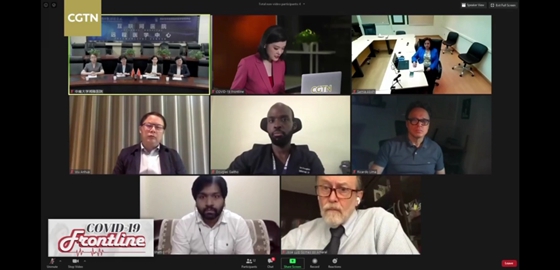On the evening of May 18th (Beijing time), the special program “Global Outbreak Consultation Room” of China Global Television Network (CGTN) held a Xiangya special session, inviting Professor Wu Anhua, an outstanding anti-epidemic individual, and Professor Huang Xun, Director of the Hospital’s Infection Control Center, Professor Huang Yan, Deputy Director of the Department of Infectious Diseases, Professor Zhang Lina, Deputy Director of the Department of Critical Care Medicine, Associate Professor Li Min, Deputy Director of the Department of Respiratory Medicine, and colleagues from India, Turkey, Egypt, Kenya, Brazil and other countries in Asia, Africa and Latin America to share their experience in prevention and control of nosocomial infections, treatment of critically ill patients, management of quarantine wards, and management of asymptomatic infected persons. The online discussion attracted the attention of 1.15 million netizens worldwide, of which overseas reads reached 877,000.
Dr. José Luiz Gomes do Amaral, Professor of the Discipline of Anesthesiology, Pain and Intensive Care of Department of Surgery in Federal University of Sao Paulo, Brazil, Academician of National Academy of Medicine, Dean of Academy of Medicine of Sao Paulo, and President of the Medical Association of Sao Paulo, Dr. Ricardo Lima, Chief Leader of COVID-19 Project and Director of ICU of Samaritan Hospital in Sao Paulo, Brazil, Dr. Sema Turan, Intensive Care Specialist of Ankara City Hospital in University of Health Sciences (Turkish), Dr. Harjit Bhatti, Chairman of the Progressive Medicos and Scientists Forum (India), Dr. Samia Abdh, Professor of Clinical Pathology and Director of Department of Infection Control of Faculty of Medicine in Ain Shams University (Egypt) and Director of the Department of Infection Control, and Mr. Douglas Gaitho, an Infectious Disease Researcher at the Aga Khan University Hospital in Nairobi, Kenya, participated in the online discussion.

“Asymptomatic patients may appear in the emergency room or even in surgical operations. How should the management be strengthened?" Dr. José Luiz Gomes do Amaral, academician of the Brazilian National Academy of Medicine, raised this doubt to Xiangya experts. Professor Wu Anhua suggested that once an asymptomatic infected person is found, it is necessary to isolate him/her and pay close attention to whether he/she will develop into a symptomatic patient. Both incubation patients and asymptomatic patients are contagious and must be isolated to prevent transmission to others. Combining the situations and experience of the epidemic prevention in Wuhan and Jilin, Professor Wu Anhua said that as long as the cases are found in time, the source and close contacts are investigated as soon as possible, and corresponding control measures are taken, it is possible to effectively prevent the deterioration of the situation. Professor Huang Xun suggested that different methods of screening should be carried out according to the degrees of risk in different regions.
Douglas Gaitho, an Infectious Disease Researcher at the Aga Khan University Hospital in Nairobi, Kenya, is very concerned about the early identification of critically ill patients. Professor Zhang Lina suggested that, because it is difficult to repeatedly review the lung CT images of the patients with COVID-19, ultrasound examination of the lungs can be routinely carried out next to the patient's bed every day to pay attention to the progression of the lungs in time. Once the patient has multiple, large-area diffuse lung injury changes, it may turn into critical illness. In addition, if the patient has a strong spontaneous breathing effort, this is a very strong signal indicating that we need to intervene and protect the lungs from damage.
“If a patient has both COVID-19 and severe myocarditis, how should he/she be managed?" Dr. Ricardo Lima, Chief Leader of the COVID-19 Project at the Samaritan Hospital in Sao Paulo, Brazil, is very concerned about the management of COVID-19 patients with other diseases. Associate Professor Li Min suggested that for such patients, early multidisciplinary cooperation is very important. While treating COVID-19, it is necessary to observe and treat comorbidities very closely. For example, when a patient has significantly increased creatase, coronary heart disease attack must first be checked. However, many patients do not have myocardial infarction, and the increase in this indicator is the manifestation of the COVID-19 with cytokine storm.
“In the case of no conditions for nucleic acid testing, how long do we have to ask patients to stay in the hospital to be sure they can safely return to society?” Dr. Harjit Bhatti, Chairman of the Progressive Medicos and Scientists Forum (India), raised the issue of discharge standards. Professor Huang Yan suggested that, from the perspective of previous cases, the duration of the virus is about three weeks, not longer than one month. If there is no condition for nucleic acid testing, it is recommended that the quarantine time is about 1 month before discharge, which is safer. It is better to do IgM antibody detection if the conditions allow, when the antibody test is negative and the quarantine time is up to 1 month, it may be safer to go back, but it is still necessary to emphasize that self-quarantine should be continued after going back.
Regarding the classification management of different COVID-19 patients concerned by Dr. Samia Abdh of the Faculty of Medicine, Ain Shams University (Egypt), Xiangya experts suggested to classify the patients as soon as possible according to the age, the underlying disease, the severity of lung injury, the oxygenation status, existence of dysfunction of other organs, etc., and send them to different wards for corresponding treatment.
In addition, Chinese and foreign experts also conducted deep discussions on the prevention and control of nosocomial infections, diagnostic criteria, specific drugs, epidemic situation analysis, and home quarantine of asymptomatic infected persons.
Source: Xiangya Hospital











